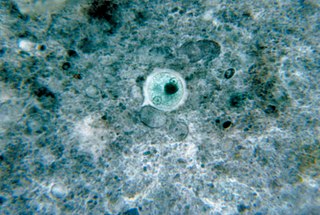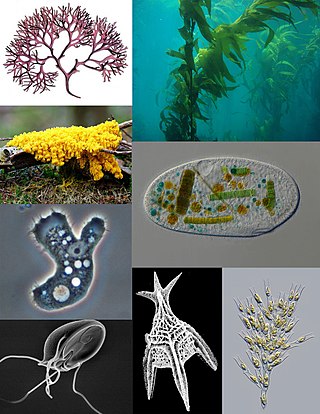
A microorganism, or microbe, is an organism of microscopic size, which may exist in its single-celled form or as a colony of cells.

Nutrition is the biochemical and physiological process by which an organism uses food to support its life. It provides organisms with nutrients, which can be metabolized to create energy and chemical structures. Failure to obtain sufficient nutrients causes malnutrition. Nutritional science is the study of nutrition, though it typically emphasizes human nutrition.

Parasitism is a close relationship between species, where one organism, the parasite, lives on or inside another organism, the host, causing it some harm, and is adapted structurally to this way of life. The entomologist E. O. Wilson characterised parasites as "predators that eat prey in units of less than one". Parasites include single-celled protozoans such as the agents of malaria, sleeping sickness, and amoebic dysentery; animals such as hookworms, lice, mosquitoes, and vampire bats; fungi such as honey fungus and the agents of ringworm; and plants such as mistletoe, dodder, and the broomrapes.
An anaerobic organism or anaerobe is any organism that does not require molecular oxygen for growth. It may react negatively or even die if free oxygen is present. In contrast, an aerobic organism (aerobe) is an organism that requires an oxygenated environment. Anaerobes may be unicellular or multicellular. Most fungi are obligate aerobes, requiring oxygen to survive. However, some species, such as the Chytridiomycota that reside in the rumen of cattle, are obligate anaerobes; for these species, anaerobic respiration is used because oxygen will disrupt their metabolism or kill them. Deep waters of the ocean are a common anoxic environment.

A heterotroph is an organism that cannot produce its own food, instead taking nutrition from other sources of organic carbon, mainly plant or animal matter. In the food chain, heterotrophs are primary, secondary and tertiary consumers, but not producers. Living organisms that are heterotrophic include all animals and fungi, some bacteria and protists, and many parasitic plants. The term heterotroph arose in microbiology in 1946 as part of a classification of microorganisms based on their type of nutrition. The term is now used in many fields, such as ecology in describing the food chain.

A parasitic disease, also known as parasitosis, is an infectious disease caused by parasites. Parasites are organisms which derive sustenance from its host while causing it harm. The study of parasites and parasitic diseases is known as parasitology. Medical parasitology is concerned with three major groups of parasites: parasitic protozoa, helminths, and parasitic arthropods. Parasitic diseases are thus considered those diseases that are caused by pathogens belonging taxonomically to either the animal kingdom, or the protozoan kingdom.

Pont-Saint-Esprit is a commune in the Gard département in southern France. It is situated on the river Rhône and is the site of a historical crossing, hence its name. The Ardèche flows into the Rhône, just to the north of the bridge. The residents are called Spiripontains.

Subacute bacterial endocarditis, abbreviated SBE, is a type of endocarditis. Subacute bacterial endocarditis can be considered a form of type III hypersensitivity.
Antiprotozoal agents is a class of pharmaceuticals used in treatment of protozoan infection.

Biology is the scientific study of life. It is a natural science with a broad scope but has several unifying themes that tie it together as a single, coherent field. For instance, all organisms are made up of cells that process hereditary information encoded in genes, which can be transmitted to future generations. Another major theme is evolution, which explains the unity and diversity of life. Energy processing is also important to life as it allows organisms to move, grow, and reproduce. Finally, all organisms are able to regulate their own internal environments.

A microbial cyst is a resting or dormant stage of a microorganism, usually a bacterium or a protist or rarely an invertebrate animal, that helps the organism to survive in unfavorable environmental conditions. It can be thought of as a state of suspended animation in which the metabolic processes of the cell are slowed and the cell ceases all activities like feeding and locomotion. Encystment, the formation of the cyst, also helps the microbe to disperse easily, from one host to another or to a more favorable environment. When the encysted microbe reaches an environment favorable to its growth and survival, the cyst wall breaks down by a process known as excystation. In excystment, the exact stimulus is unknown for most protists.

Protozoan infections are parasitic diseases caused by organisms formerly classified in the kingdom Protozoa. They are usually contracted by either an insect vector or by contact with an infected substance or surface and include organisms that are now classified in the supergroups Excavata, Amoebozoa, SAR, and Archaeplastida.

A protist or protoctist is any eukaryotic organism that is not an animal, plant, or fungus. Protists do not form a natural group, or clade, but an artificial grouping of several independent clades that evolved from the last eukaryotic common ancestor.

A fungus is any member of the group of eukaryotic organisms that includes microorganisms such as yeasts and molds, as well as the more familiar mushrooms. These organisms are classified as a kingdom, separately from the other eukaryotic kingdoms, which, by one traditional classification, includes Plantae, Animalia, Protozoa, and Chromista.

Protozoa are a polyphyletic group of single-celled eukaryotes, either free-living or parasitic, that feed on organic matter such as other microorganisms or organic debris. Historically, protozoans were regarded as "one-celled animals", because they often possess animal-like behaviours, such as motility and predation, and lack a cell wall, as found in plants and many algae.

The clothing worn by plague doctors was intended to protect them from airborne diseases during outbreaks of bubonic plague in Europe. It is often seen as a symbol of death and disease. However, the costume was mostly worn by a late Renaissance and early modern physicians studying and treating plague patients.
In biology, a pathogen, in the oldest and broadest sense, is any organism or agent that can produce disease. A pathogen may also be referred to as an infectious agent, or simply a germ.
The initial version of a classification system of life by British zoologist Thomas Cavalier-Smith appeared in 1978. This initial system continued to be modified in subsequent versions that were published until he died in 2021. As with classifications of others, such as Carl Linnaeus, Ernst Haeckel, Robert Whittaker, and Carl Woese, Cavalier-Smith's classification attempts to incorporate the latest developments in taxonomy., Cavalier-Smith used his classifications to convey his opinions about the evolutionary relationships among various organisms, principally microbial. His classifications complemented his ideas communicated in scientific publications, talks, and diagrams. Different iterations might have a wider or narrow scope, include different groupings, provide greater or lesser detail, and place groups in different arrangements as his thinking changed. His classifications has been a major influence in the modern taxonomy, particularly of protists.

The plasmodiophores are a group of obligate endoparasitic protists belonging to the subphylum Endomyxa in Cercozoa. Taxonomically, they are united under a single family Plasmodiophoridae, order Plasmodiophorida, sister to the phagomyxids.
The siege of Caffa was a siege of the Genoese port town of Caffa by a large Crimean Tatar army under the Golden Horde, led by their Khan Jani Beg. The Mongol army threw the bodies of Mongol warriors who had died of plague over the walls of the besieged city, which is considered one of the earliest examples of biological warfare. On the basis of Gabriel de Mussis' writings, the Black Death is widely believed to have reached Europe from the Crimea as the result of the biological warfare attacks during the siege.














